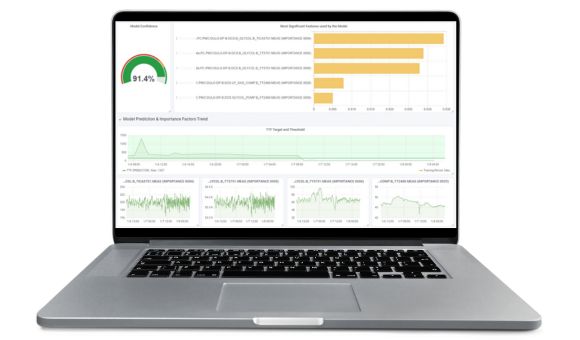By leveraging the power of time series data, advanced analytics and AI, businesses can gain valuable insights into their operations, identify trends and patterns, and make informed decisions to optimize their processes.
Time series data can be used to gain insights into trends and patterns over time, and to forecast and predict future outcomes.
Time series data is simply a sequence of data points that are collected over time at regular intervals. These intervals can be as short as every millisecond, or as long as every year, depending on the nature of the data being collected. For example, weather data is often collected every hour, while stock market data is collected every minute or even every second.
What makes time series data so powerful is its ability to capture changes and trends over time. By analysing this data, we can identify patterns and relationships between different variables, and use this information to make predictions about future outcomes. This is especially useful in industrial applications, where time series data can be used to monitor and optimize production processes, predict machine failures, and forecast energy consumption.

One of the challenges of working with time series data is its sheer volume. For example, a single crane with 2,500 sensors can produce four billion data points in one year alone. Collecting and storing large amounts of data can be expensive and time-consuming, and analysing this data in real-time can be a daunting task. This is where advanced analytics and AI come in. By leveraging the power of machine learning algorithms, we can analyse time series data in real-time, identify patterns and trends, and make predictions about future outcomes.
At VROC, we specialize in working with time series data, and our platform has been designed to help businesses of all sizes leverage the power of this data. Our DataHUB+ platform can host, store, and easily analyse and visualize large volumes of historical and real-time data, and our advanced no-code AI platform, OPUS can help predict deviations in how equipment and processes should be performing (based on historical trends) vs how it is predicted to perform (based on live data).
One of the most exciting applications of time series data is in forecasting. By analysing historical data and identifying patterns and relationships between different variables, we can make predictions about future outputs, production rates and utilization with a high degree of accuracy. This is particularly useful in industries like energy, where accurate forecasting can help businesses make informed decisions, optimizing operations to stay ahead of the competition. In an example, AI was able to forecast energy supply rates for the improvement of the energy supply network.
Time series data can also be used to for anomaly detection and improve predictions for asset time to failure and predictive maintenance. By analysing time series data from across an entire industrial plant (holistic analysis), businesses can gain a holistic view of their operations and identify potential issues before they become major problems. For example, by monitoring the temperature, vibration, and other variables of critical equipment, businesses can detect anomalies and predict when maintenance is needed, minimizing downtime and reducing costs. This kind of holistic approach to time series data can help businesses optimize their operations. In one, example an oil and gas operator used AI to gain critical insights into the clogging of their Produced Water Filter. The predictions allowed them to prevent production delays and optimize their internal processes.
It’s important to note that forecasting and predictive analytics are not always straightforward. There are many factors that can influence the accuracy of these predictions, and even experienced machine learning practitioners can be surprised by the complexities of time series forecasting. For example, changes in external factors like weather patterns or economic conditions can have a significant impact on the accuracy of forecasts, and even minor changes in data collection or processing can affect the outcome.
Despite these challenges, time series data remains an incredibly powerful tool for businesses of all sizes. By leveraging the power of advanced analytics and no-code AI, businesses can gain valuable insights into their operations, identify trends and patterns, and make informed decisions to optimize their processes and improve their bottom line. With the right tools and expertise, time series data can be a game-changer for businesses in a wide range of industries.
Discover more capabilities of applying AI to time series data here.
Empowering decision making and operational efficiency with AI on an offshore platform in Central Asia.
Read ArticleInterested in a demo of one of our data solution products?
DataHUB4.0 is our enterprise data historian solution, OPUS is our Auto AI platform and OASIS is our remote control solution for Smart Cities and Facilities.
Book your demo with our team today!
Ready to embark on a pilot project or roll-out AI innovation enterprise wide? Perhaps you need assistance integrating your systems or storing your big data? Whatever the situation, we are ready to help you on your digital transformation.
The efficient deployment, continuous retraining of models with live data and monitoring of model accuracy falls under the categorisation called MLOps. As businesses have hundreds and even.
Learn more about DataHUB+, VROC's enterprise data historian and visualization platform. Complete the form to download the product sheet.
Discover how you can connect disparate systems and smart innovations in one platform, and remotely control your smart facility. Complete the form to download the product sheet.
'OPUS, an artistic work, especially on a large scale'
Please complete the form to download the OPUS Product Sheet, and discover how you can scale Auto AI today.
Interested in reading the technical case studies? Complete the form and our team will be in touch with you.
Subscribe to our newsletter for quarterly VROC updates and industry news.